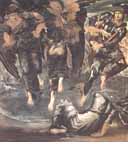 Sir Edward Burne-Jones painted The Death of Medusa as part five of his unfinished series on the Perseus. He completed the first four scenes in the cycle, but the last four remain incomplete, only as cartoons. This particular scene depicts Perseus wearing the winged sandals of Venus and clutching Medusa's head as he attempts to flee her lair. The two large winged figures giving chase to Perseus are presumably the Gorgons, Medusa's sisters. Medusa herself lies below, so recently decapitated by Perseus that she remains slightly upright. Burne-Jones leaves little of the background visible, but the small spaces between the bodies reveal a craggy, lifeless landscape. The lack of background can be largely attributed to the fact that the artist pushes the figures so close to the picture plane that he leaves no room for it. A jumble of wings and limbs comprise the majority of the composition, using very little sense of perspective; the arms especially appear odd due to the awkward foreshortening. The sense of claustrophobia, reminiscent of Rossetti's works such as his Annunciation, leaves the action of the scene uncertain. Without previous knowledge of the myth, the identity and purpose of the Gorgons seems unclear at best. although the lack of color gives the scene an "unearthly, ghostly feeling, partly because of their raw surface, and the extreme angularity of the figures" (Wood, 124), this could possibly be attributed to its unfinished status. The lack of modeling in the faces does not hinder their beauty however, as Burne-Jones paints them with a certain degree of elegance and gracefulness.
Sir Edward Burne-Jones painted The Death of Medusa as part five of his unfinished series on the Perseus. He completed the first four scenes in the cycle, but the last four remain incomplete, only as cartoons. This particular scene depicts Perseus wearing the winged sandals of Venus and clutching Medusa's head as he attempts to flee her lair. The two large winged figures giving chase to Perseus are presumably the Gorgons, Medusa's sisters. Medusa herself lies below, so recently decapitated by Perseus that she remains slightly upright. Burne-Jones leaves little of the background visible, but the small spaces between the bodies reveal a craggy, lifeless landscape. The lack of background can be largely attributed to the fact that the artist pushes the figures so close to the picture plane that he leaves no room for it. A jumble of wings and limbs comprise the majority of the composition, using very little sense of perspective; the arms especially appear odd due to the awkward foreshortening. The sense of claustrophobia, reminiscent of Rossetti's works such as his Annunciation, leaves the action of the scene uncertain. Without previous knowledge of the myth, the identity and purpose of the Gorgons seems unclear at best. although the lack of color gives the scene an "unearthly, ghostly feeling, partly because of their raw surface, and the extreme angularity of the figures" (Wood, 124), this could possibly be attributed to its unfinished status. The lack of modeling in the faces does not hinder their beauty however, as Burne-Jones paints them with a certain degree of elegance and gracefulness.
Burne-Jones' affair with sculptress Maria Zambaca holds prominence in Burne-Jones' biography; it affected him so much that her attempted suicide marks a turning point in the body of his art. Bill Waters explains that "During the period of most unhappiness, from about 1870-1875, the angst felt by the lovers permeates the works he was creating; his figures became angular, their expression often painful and his lines became nervous, gestural and erratic" (Waters, 12). This seems evident in The Death of Medusa when compared to the graceful linearity of some of Burne-Jones' earlier works such as his Venus of 1861. Burne-Jones still utilizes a linear composition, such as the curve of Medusa's body, but not to the extent of some of his previous paintings.
Questions
1. The Perseus series and The Briarose series remain two of Burne-Jones most famous projects today. Why did Burne-Jones choose a medieval focus? Does this fit in with the ideas of other Pre-Raphaelite artists?
2. Why do you think Burne-Jones chose to paint such a barren landscape for this scene? Does it add meaning to the subject matter?
3. The myth itself considers Perseus' murder of Medusa a good deed, in that it freed her from her tormented life. Does Burne-Jones illustration convey this? How much emotion does the artist include, and in what ways?
4. Besides some of the archaizing tendencies of Rossetti, what other evidence of a PRB influence appear in this work? In what ways does it mark a departure?
Last modified 28 October 2004